The Frank J. Remington Center houses one of the oldest, largest, and most diverse clinical programs in American legal education. Founded by UW Law Professor Frank Remington almost fifty years ago, the Center’s primary purpose remains the education of law students. Prisons, prosecutors and defender offices, and the communities of victims are the primary settings for the students’ experiential education.
The Remington Center now houses nine of the UW Law School’s in-house clinics, and two of its largest externship opportunities. Located in the Law School building and staffed by approximately 11 clinical faculty members, the Remington Center provides an intensive clinical experience to approximately 85 students each year. Most of the clinical projects include a full-time summer component followed by part-time enrollment in the fall and spring semesters. In addition, most of the in-house clinics, and all of the externship clinics, include a classroom component.
Clinics & Projects
Historically, the Remington Center originated by serving incarcerated clients. The Center continues to house several clinical projects devoted to serving correctional clients, including:
- Legal Assistance to Incarcerated People (LAIP), in which law students assist inmates in the Wisconsin Prison System with civil and criminal law issues;
- Oxford Federal Project, in which students assist inmates in the Federal Correctional Institution in Oxford, Wisconsin with civil and criminal law issues;
- Wisconsin Innocence Project (WIP), in which students investigate, and where appropriate litigate, inmates’ claims of actual innocence based on new evidence;
- Restorative Justice Project (RJP), in which students explore restorative justice as an alternative to the adversarial nature of the criminal justice system, including facilitating victim-initiated conferences with offenders;
- Criminal Appeals Project (CAP), in which students represent clients on direct appeal from their criminal convictions;
- Federal Appeals Project (FAP), in which students represent clients on direct appeal from their federal criminal convictions.
- Second Look Clinic, in which students represent people incarcerated in Wisconsin state prisons who are serving excessive sentences. Students work closely with their incarcerated clients to develop persuasive arguments about why clients should be released from prison.
Finally, the Remington Center houses two longstanding externship projects, the Prosecution Project and the Public Defender Projects. In these projects, students spend the summer working full-time in district attorney or public defender offices throughout Wisconsin. The students’ externship experience is sandwiched between a spring semester class on the prosecution or defense function and a fall-semester seminar in professional responsibilities, in which the students reflect on their experiences.
The History of the FJR Center
The Early Years: 1963-1975
In 1963, Frank Remington, with his colleagues Don Newman and Margo Melli, agreed that preparation of future lawyers should not be limited by what could be taught and learned in the classroom. Law students needed experience to complement their classroom endeavors, for "only through firsthand experience can the young lawyer hope to develop adequate professional capacity to make a contribution."
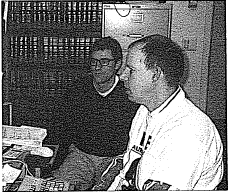
Starting Small
Professors Remington, Newman, and Melli launched an experiment called the Law Student Correctional Internship Program. The first eight interns went out into the field in the summer of 1964. The program was not "on-the-job" training for positions the law student might later hold. Rather, the idea was to broaden the student's exposure to complex social and legal issues via in-depth experience in areas with which the student might not be directly involved over the course of a professional career. That experience, initially, took place in prisons.
Combining classroom preparation, observation in prison settings, and reflective writing, the young program flourished. Students were eager to participate and it generated faculty interest and support, as well as the cooperation of corrections personnel. It helped establish criminal justice as a respectable field of academic study and professional education in a time when criminal law was a narrow field of study incidental to a comprehensive legal education at most law schools.
In its first few years, the summer internship program was primarily an opportunity for law students to observe the correctional system in action:
- One law student acted as "chauffeur" for members of the Wisconsin Parole Commission and sat in on all parole hearings.
- Another student assisted with recreation programs at a prison.
- A third acted as an assistant social worker.
Gaining Recognition
The heightened profile of law students in the correctional facilities quickly brought demand for legal services, initially from prison staff on behalf of inmates and then from the inmates themselves. Against a backdrop of increasing litigation in federal and state courts concerning prisoner rights and grievances, correctional student interns were often pressed for legal advice and help with family issues, review of convictions, and sentence modification.
Beginning in 1969, Professor Remington and the Division Oater Department of Corrections concluded that law students might effectively assist inmates with their legal concerns and that the resolution of outstanding legal problems of the incarcerated would make successful reintegration into communities more likely. This was the beginning of a more formal legal services program for prisoners.
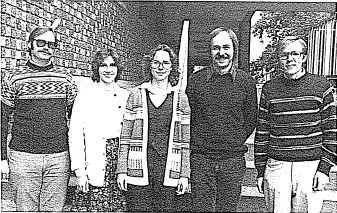
Talsky.
Professor Remington encouraged supervising attorneys and students to develop a partnership with corrections staff, building trust and helping to solve problems. He recognized that the Law School and the corrections system could learn a great deal from each other. There is no more concrete demonstration of the value of the Program than the fact that during its entire history, at least half of its funding (now three quarters of a million dollars annually) has come from Corrections.
The Wisconsin Idea - Beyond the Academics
Professor Remington and the first Director of the Program, Walter J. Dickey, frequently described LAIP as a "learning center" for the development of knowledge through the direct experience of students and attorneys and through more formal research, and for the dissemination of that knowledge to those who would use it.
As a "learning center," LAIP reflected "the Wisconsin Idea"-the use of University resources in the ongoing quest to advance research, education, and service throughout the state and nation. Professors Dickey and Remington believed LAIP should play a vital role in the improvement of the state's criminal justice system and be a model for other states.
Thus, over the years, insights derived from the LAIP experience have been shared with not only the academic world, but also with:
- The legal profession through writing, continuing education programs, and bar meetings
- The correctional system through advice and rule drafting
- The legislature through assistance to committees, testimony, and legislative drafting
- The public through the media and public speaking.
Program students and attorneys have played vital roles in the development of numerous statutes and administrative and judicial rules.
The life blood of the Program remains its students. As lawyers, Program graduates have an exceptional understanding of the complex operations of the criminal justice system, and many have gone on to positions as state and federal prosecutors, public defenders, judges and private lawyers.
Other graduates have taken positions in corrections - including current Faculty Director Walter J. Dickey, who spent four years as the head of the Wisconsin Department of Corrections (DOC); Stephen Bablitch, who succeeded him in that position; and Mary Wilburn, who served as Chair of the Wisconsin Parole Commission.
Expansions in Education and Service: 1975 - 1990
In the mid-1970s, the Legal Assistance to Institutionalized Persons project (LAIP) took on the basic shape that it would retain into the early 1990s. From a small number of interns, all of whom worked at one prison, then called the Wisconsin State Prison (now Waupun), the Program expanded to the Wisconsin State Reformatory at Green Bay, the Fox Lake Correctional Institution, and the prison for women at Taycheedah, Wisconsin.
When Wisconsin sold its newly built prison at Oxford to the United States Bureau of Prisons in 1974, the Program moved to provide services in the new federal prison and to diversify the educational opportunities afforded law students. In the mid-1970s, the Program also began to provide services at the three state mental health institutions. Student interns were initially assigned to Central State Hospital, where they provided legal services for mental patients under criminal commitments. These clients proved to be challenging for the law students, since communication was difficult and the patients' criminal commitments raised complex legal issues.
Fundraising
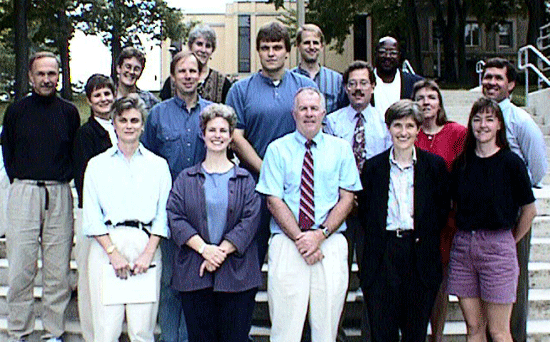
In 1974, the Program's original grant expired, precipitating a financial crisis. Professor Remington persuaded the legislature to add funding for the program to the University's budget, reflecting the high regard in which he was held and the importance of the Program to the criminal justice system of the state. These legislative funds, added to the Law School's base budget in 1975, are a cornerstone of Program funding.
Contracts with the Wisconsin DOC, the Federal Bureau of Prisons, the Wisconsin State Public Defender, and the two dozen Wisconsin counties in which prosecution interns work provide the other half of funding for the Program. This contract funding has continued for more than twenty years, a tribute to the quality of the Program and the respect it commands in the legislature and other government circles.
Moving and Remodeling Buildings
With the new funding in place, the Program continued to thrive. LAIP had quickly outgrown the space the law building could provide for it. In 1975, Professors Remington and Dickey persuaded the University to make available an old building near the Law School that had once housed the old Blackhawk Cafe and then was home to the State Crime Laboratory. The poor physical condition of the building made it ill-suited for LAIP use, but it did provide some muchneeded office space for supervising attorneys. Professors Remington and Dickey quickly went to work raising money within the university to remodel the building. They felt that a favorable working environment would help law students develop a professional orientation toward service to clients. By 1979, the building provided an office for every supervising attorney and secretary, a modest library collection, and a desk for every student intern. A way from the distractions of other Law School activities, the new space afforded students an opportunity to immerse themselves in the Program.
Professors Dickey and Remington continually tried to create an exemplary professional working environment. The importance attached to professionalism was also shown in the high priority given to providing some compensation in the summer months, enabling interns to avoid the distractions of work in other places. Gathered together in one building, the students were also able to learn from one another as they discussed their common experiences and concerns.
Expanding the Vision
LAIP came to serve many more students each year, yet the general format remained very close to that of the original internship program. It was an "immersion" experience in the correctional system. At the start of the summer, classroom instruction provided basic information on the justice system and professional responsibility. Students then interviewed clients at the correctional and mental health institutions. Through discussion with other students and clinical faculty, they developed approaches to handling individual problems and a broad understanding of the lawyer-client relationship and the criminal justice system. They drafted legal documents and argued cases in court. And they were exposed to leaders in the field of criminal justice who, as visitors to the Law School, offered their perspectives on current problems to assembled students. Twice-weekly meetings afforded the opportunity for discussion on a broad range of topics, from the guilty plea to detainers to the representation of convicted offenders.
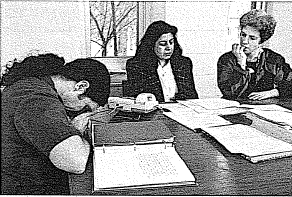
This immersion experience - a group of people gathered in a professional atmosphere, working fulltime in service of clients and using diverse methods to advance that service and their own education - is still the core method of the Remington Center and it is used, with slight variation, in all its projects.
An essential ingredient necessary to execute this educational philosophy is a "place" where attorneys, faculty, students and guests can work together - to develop professional habits and to grow from the formal interaction and the informal. So when the Program offices at 913 University Avenue were demolished in 1991 to make way for a new building for the Business School, the Program moved to quarters a few blocks away, at 212 N. Bassett Street. Although farther away from the Law School, the Bassett Street building did provide enough space for the continually growing LAIP program. As the reputation of LAIP grew among law students, and the Wisconsin prison system expanded, summer internships increased from eight (in 1964) to fifteen (in 1974) to forty (in 1980) to fifty-five (in 1991).
The collegiality fostered by Professors Remington and Dickey has always provided opportunities for clinical faculty and students to develop new ideas. Over the years, they and the clinical faculty recognized that it was necessary to move beyond simply corrections in order to adequately educate law students and to enhance the quality of the criminal justice system. In 1987, Clinical Assistant Professor David Cook created the Victim-Offender Reconciliation Program (VORP). This new project brought victims and offenders together after conviction in order to help victims to heal and help offenders understand and take responsibility for what they had done. Typically, after a good deal of preparation, the offender met the victim, apologized for the harm, listened to the victim explain the effect of the crime, and acknowledged responsibility for it. This groundbreaking program would go on to become what is known today as the Restorative Justice Project, the first such program for sentenced prisoners. It continues to result in moving encounters, rewarding for every one involved, including the law student. The Restorative Justice Project has established a national reputation and has been instrumental in the development of community-based projects throughout Wisconsin and in many other states.
Similarly, in the late 1980s, Professors Remington and Dickey concluded that a project aimed at law students who wanted to become criminal prosecutors would help to enhance the quality of prosecution in Wisconsin. Accordingly, they convinced the Wisconsin Legislature to provide a permanent appropriation to fund the Prosecution Project, which would develop and implement summer field placements in prosecutors' offices throughout Wisconsin. In 1990, Clinical Associate Professor Ben Kempinen took over the fledgling project. Under his guidance, the Prosecution Project has grown to include 25 students each summer, who work in over twenty district attorney offices throughout Wisconsin. A few years later, Clinical Associate Professor Michele LaVigne, with funding from the Wisconsin State Public Defender, developed a similar summer placement experience in public defender offices around the state. In both projects, a spring semester class component and a fall semester reflective seminar complement the students' summer placement.
1990 - Present
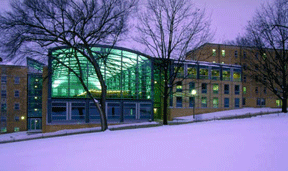
The 1990s marked another period of remarkable change for the Program. In 1993, Professor Remington retired from the Law School. Although he had ceased day-to-day involvement in LAIP matters, his influence continued to be widely felt and his advice sought by students and faculty alike. Professor Remington passed away in early 1996.
In the fall of 1996, when the offices were completed in the newly expanded and renovated law school, the faculty unanimously agreed that the Program, as Professor Remington called it, be renamed "The Frank J. Remington Center for Education, Research, and Service in Criminal Justice." The Remington Center was dedicated on November 8, 1996, in a ceremony that included family, friends, colleagues, and students.
The development of the Remington Center's new offices coincided with some substantive changes in the organization of the projects housed there. The second half of the 1990s saw remarkable developments in the Center, all designed to provide students with the educational experience that Professor Remington believed in so strongly. The Center, now staffed by a greater number of highly experienced supervising attorneys, began to take on more complex family law and postconviction cases. Further, demand among law students for involvement in clinical work during the academic year was growing beyond what Center staff could manage while maintaining high standards of teaching, writing and service. The Center's history of experimentation and adjustment to the changing landscape of legal education and criminal justice is reflected in its current shape. At the turn of the century, the Center had eight clinical projects.
The Center continues moving ahead and changing with the technological developments of the twenty-first century and adapting to new circumstances, both internal and external. The educational model remains the same.
The Center's Vision for the Future
The clinical faculty, students, and staff of the Remington Center believe that the Frank J. Remington Center is effectively carrying out Frank Remington's vision of a "learning center." Recent changes in organization and course work have allowed the Center to refine the educational experience of law students and services to its clients. While the Center is often viewed as a criminal law program, its main interest is in the development of high quality lawyers, whatever substantive legal interests they may pursue.
The Remington Center is in a constant state of self-evaluation and refinement, efforts that demand experience and reflection. For more than forty years, the Center has been providing students the opportunity to stretch as fledgling legal practitioners. As we move forward in the 21st century, the Center will continue to experiment, reflect, and grow.
A 30-Year Reflection: by John Norsetter »
About Frank J Remington »
Timeline
| 1963 | Professor Frank Remington begins to develop idea for correctional internship program. |
|---|---|
| 1964 | Eight interns complete the Correctional Internship Programs at two institutions. |
| 1969 | Supreme Court rules in Johnson v. Avery that correctional systems must provide a law library or other legal system for inmates. The LAIP interns were made available to provide this legal advice. Student interns begin to be assigned to the Central State Hospital. First grant expires. |
| 1971 | First supervising attorneys are hired. |
| 1974 | Fifteen interns participate in LAIP. Programs expand to include the new federal prison in Oxford. The Wisconsin Council on Criminal Justice grant expires. |
| 1975 | Legislative funds for LAIP are added to the Law School's base support. LAIP moves to the old State Crime Laboratory at 913 University Avenue.Walter J. Dickey is named Director of the LAIP program. |
| 1977 | Clinical Associate Professor Ben Kempinen helps draft Wisconsin Statute section 973.155, mandating sentence credit in appropriate cases. |
| 1978 | Legislature requires the Department of Corrections to comply with the State Administrative Procedure Act. Walter Dickey is given the job of rewriting the Department's rules. |
| 1980 | Forty interns participate in LAIP. Diane Collins is hired as secretary for the program. |
| 1981 | LAIP again encounters funding problems. Professors Remington and Dickey ask for students to write to the Law School attesting the importance of the program. State funding is then established. |
| 1983 | Professor Dickey becomes the director of the Department of Corrections |
| 1985 | Ben Kempinen is involved in drafting revisions to "good time laws," legislation that credited inmates for time already served. Paralegal work begins in the Fox Lake Correctional Institution with two inmates, including Bobby Austin. |
| 1986 | Ken Lund becomes director of LAIP. |
| 1987 | David Cook begins the Victim-Offender Reconciliation Program, later renamed the Restorative Justice Project. |
| 1989 | Catherine Manning award, for outstanding LAIP students is established in memory of the late supervising attorney, Catherine Manning. |
| 1990 | Crime lab building at 913 University Avenue is demolished. Program moves to 212 N. Bassett Street. Ben Kempinen takes over as director of an expanded Prosecution Project. |
| 1991 | Fifty-five interns participate in LAIP. Meredith Ross becomes Deputy Director of LAIP. Public Defender Project is launched with Michele LaVigne as director. |
| 1993 | Frank Remington retires from the Law School faculty but continues as emeritus professor. Law School begins construction of an expansion of the existing building to include LAIP offices. |
| 1994 | Criminal Appeals Project begins with Kate Kruse as director. |
| 1995 | Restorative Justice Project arranges meeting between Jackie Millar and Craig Sussex. |
| 1996 | Frank Remington passes away.The expansion of the Law School is completed and the Program moves into the new building. The Frank J. Remington Center for Education, Research and Service in Criminal Justice is dedicated. Meredith Ross becomes director of the Center. Neighborhood Law Project launched to provide legal services to the poor in Madison. |
| 1997 | The Family Law Project is created with Kate Kruse as director. |
| 1998 | The Innocence Project is created with John Pray and Keith Findley as co-directors. |
| 1999 | Michele LaVigne starts the Delavan Project, a mock trial for deaf students. |
| 2000 | 110 students are offered internships in the eight programs at the Remington Center. Diane Collins celebrates 20 years at the Center. Meg Gaines starts the Patient Advocacy Project, later renamed the Center for Patient Partnerships. |
| 2012 | Meredith Ross retires as director of the Center. The civil clinics within the Remington Center are reorganized under the umbrella of the Economic Justice Institute, which is now distinct from the Remington Center. |
| 2013 | The Federal Appeals Project is created with Adam Stevenson as director. |
